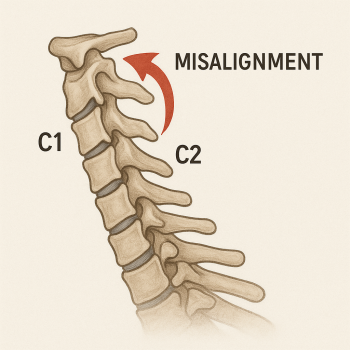
Fibromyalgia is a complex physiological condition that is characterized by chronic widespread pain throughout the the body. It is a poorly understood condition in both its cause and finding an effective fibromyalgia treatment is frustrating for many people. The clinical diagnosis of fibromyalgia is based exclusively upon symptomatology, meaning that the experience of pain and reported symptoms is still the primary method of diagnosis.
As of now, there are no specific tests that are used to detect fibromyalgia, making it an “invisible” condition. Since fibromyalgia is not visible on an MRI, identifiable in a blood test, or measurable objectively, most fibromyalgia treatments are focused on symptom management rather than finding and fixing the cause. Chiropractic Doctors who focus in the upper cervical spine have identified overlooked structural injuries in fibromyalgia patients that provide hope for safe, natural, and conservative fibromyalgia treatment.
Traditionally, fibromyalgia was diagnosed by the presence of 11 or more “tender spots” spread throughout the body. Current guidelines have been expanded to include widespread pain lasting more than three months also including fatigue, irritability and mood changes, and no clear underlying cause or clear fibromyalgia treatment.
Many patients who receive a fibromyalgia diagnosis have undergone extensive and costly testing with no real answers pertaining to the cause of their pain and dysfunction. This leads to frustration, mounting healthcare costs, and often the sentiment that the pain is “all in your head.” Current research is identifying immune system biomarkers that can be measured in the bloodstream of patients with fibromyalgia, but it is uncertain if these molecules are causing pain or simply a byproduct of chronic pain. As such, this information currently does not aid in guiding fibromyalgia treatment.
While there are no widely understood causes of fibromyalgia, there are certain physiological processes that happen in fibromyalgia that are well understood and may shed light on conservative and effective fibromyalgia treatment. One of these processes is a hypersensitivity of the nervous system that results in a higher pain perception, known as “central sensitization.” Sources including the Mayo Clinic report that fibromyalgia appears to be linked to the way that the brain and spinal cord transmit and process pain signals.
As the “electrical communicating system of the body” the central nervous system serves several vital functions that may become disrupted in fibromyalgia patients. The human body is full of various types of sensors that are continually scanning the organs, muscles, and tissues of the body in order to detect changes in the body’s environment - both on the inside and outside. There are sensors to detect chemical, pressure, temperature, and positional changes to name a few. Most fibromyalgia treatments are focuses on blocking signals from sensors within the body through pharmaceutical drugs.
All the information detected by these sensors is then sent back to the brain through networks of nerves that all converge to the spinal cord and travel upward to the brain for processing. Before entering the brain, these nerve signals are processed in a region of the central nervous system called the brainstem, which is located in the spine at the junction between the head and upper neck.
The brainstem operates like the “switchboard” of the central nervous system by relaying these signals to the appropriate part of the brain for interpretation. Once these specific nerve signals reach the appropriate part of the brain, the information that they carry is interpreted and an appropriate response is issued so that the body can maintain a high level of adaptability to changes in its environment.
Consider the following example to illustrate this point and how it applies to fibromyalgia treatment:
Each home has an electrical service that ensures that each room, light, and feature of the house is adequately supplied. The electrical wires of the house carry signals from the transformer on the outside of the house to the interior fixtures, appliances, and sockets to be used for the full functionality and enjoyment of the house.
Inside the house is a fuse box which is the relay station between the high-powered transformer outside and the individual circuits inside. The fuse box contains fuses that modulate electrical energy to ensure that the right amount gets through to each part of the house.
For example, a washing machine requires more electrical energy than a ceiling fan, and so the fuse box is set up to ensure that each circuit contains just enough electrical energy to meet those demands. Too little energy and the appliance won’t work, too much energy and there is a risk of an unsafe situation such as damage to the appliance or a fire.
In the same way, the brainstem modulates the information coming from the body to the brain and then from the brain back to the body to ensure that each muscle, tissue, and organ receive the right amount of nerve energy for its function.
Fibromyalgia patients experience increased pain sensations when there is a disruption of the nerve energy between the brain and the body leading to chronic pain, fatigue, muscle aches, hormone irregularity, and more.
In order to consider appropriate fibromyalgia treatment, it is important to consider situations that may be impacting the performance of the central nervous system, especially in the brainstem region. The upper neck, also known as the upper cervical spine or craniocervical junction, is the most mobile part of the spine. As such it is susceptible to injury from forces such as slips, falls, automobile accidents, sports injuries and more.
When the alignment of this part of the spine becomes compromised, mechanical irritation can be transmitted to the surrounding tissues including the brainstem. This irritation may be the cause of the hypersensitivity of the nervous system that is producing chronic pain in fibromyalgia patients.
Upper cervical subluxation is the condition involving mechanical displacement of the junction between the head and neck and its nerve system complications, and may be the appropriate fibromyalgia treatment for some people.
Patients who are exploring their fibromyalgia treatment options should consider the structural component of their overall condition. Without appropriate detection and intervention, fibromyalgia sufferers may miss a critical component of a conservative and natural solution for dealing with their chronic pain.
The Blair Upper Cervical chiropractic technique is a specialized system of evaluating and correcting the upper cervical spine without twisting, popping, or cracking the neck.







Leave a comment